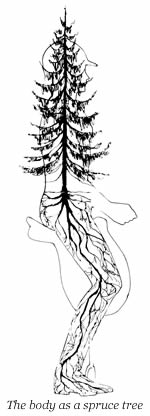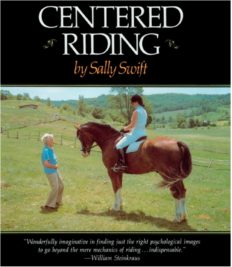Sally Swift
Born in 1913 in Hingham, Massachusetts, Sally Swift began her study with Mabel Todd as a child, just after she was diagnosed with scoliosis. Swift worked with Todd and the Boston studio teachers as often as twice a week until she was well into her twenties. Todd’s work helped her to remain active and thwart the progress of the lateral curvature to her spine. Later, Swift applied her understanding of Todd’s work to the teaching of horseback riding. She describes her early experience of Todd’s approach in the following:
When I was eight years old I was diagnosed as having a lateral curvature of the spine — technically known as scoliosis. This was probably caused by an unrecognized case of polio. In order to care for and correct my back problem, I worked with Mabel Elsworth Todd in Boston from the time I was eight years old into my early twenties. Her premise was that with our minds we can control deep, inner muscles that we would not be able to activate by moving just an arm or a leg. She wrote a book called The Thinking Body — the title gives some idea of her approach. She taught a lot of anatomy; a skeleton was always hanging nearby, and books were brought out frequently to show how muscles looked and worked. She used a great many images for teaching, such as squatting down and walking like a duck or, when walking upright, dragging an imaginary alligator’s tail along the ground. So I grew up surrounded by this teaching of anatomy and images.
By the time I was thirteen years old, I was very overdeveloped on my right side. In order to counter this, Miss Todd made me learn to write with my left hand and give up all sports that required the use of my right hand. She knew, however, that it was important that I enjoy some sort of physical activity; since horses had been my passion for as long as I could remember, she encouraged me to ride. This was excellent therapy because riding uses both sides of the body equally. In order for me to ride, however, Miss Todd sent me to an orthopedist who constructed a corset brace, leather with steel supports, which I used for many years. I took some bad spills in it, too, but never hurt my back.
By developing equal use of my two legs in riding, I strengthened the muscles in my lower body and balanced my uneven muscle tone. Miss Todd’s work prevented me from tipping off-center by making the spinal curvature compensate itself. The top of my head was above my pelvis and not off to one side, as is the case with many scoliotic people. I was very fortunate because people in my circumstances were often put into full-body casts or had spinal fusions or other unpleasant experiences I was able to avoid. I was given the freedom of many years of enormous happiness on a horse.
As a teenager, Swift practiced the body awareness she learned from Todd in her horseback riding. Images from her posture lessons would come to mind as she rode. Swift became aware that if her breathing was shallow and her body was tense, the horse became uncomfortable. When she aligned her own body better and become more relaxed, the coordination of her horse also improved. Swift taught horseback riding for twelve years using the methods of training that were established at the time. Although she was not yet bringing her knowledge of posture into her teaching, Miss Todd’s work helped her distinguish between the placement of novice and expert riders and appreciate why some teaching methods were effective while others were not.
Swift attended college to study agriculture with her major in the production and management of dairy cattle. After graduating, she worked for the American Holstein Association for thirty years. Swift’s back condition became very painful toward the end of that career. First, she sought the assistance of a teacher in England with an approach very similar to Todd’s. Later, study of the Alexander technique helped her regain muscular strength and balance and added to her repertoire of teaching techniques.
 In 1975, at the age of 62, Swift began teaching horseback riding again. Her study of somatics underscored the importance of not just conveying what to do in riding but the how and why of good riding technique. Thus, some thirty years after her first attempt to teach riding, Swift put aside conventional training methods and focused on teaching body alignment and movement efficiency to bring forth the best performance of the rider and the horse. Communicating these matters to students involved teaching basic concepts of postural anatomy in the manner of Miss Todd. Swift showed students the skeleton and pictures from anatomy books and then created imagery that captured the meaning of the alignment goals for them to picture as they rode. Her images were simple and often based in nature — one of the best-known being the body as a spruce tree, the roots growing down from the body center as the trunk grows upward toward the sky.
In 1975, at the age of 62, Swift began teaching horseback riding again. Her study of somatics underscored the importance of not just conveying what to do in riding but the how and why of good riding technique. Thus, some thirty years after her first attempt to teach riding, Swift put aside conventional training methods and focused on teaching body alignment and movement efficiency to bring forth the best performance of the rider and the horse. Communicating these matters to students involved teaching basic concepts of postural anatomy in the manner of Miss Todd. Swift showed students the skeleton and pictures from anatomy books and then created imagery that captured the meaning of the alignment goals for them to picture as they rode. Her images were simple and often based in nature — one of the best-known being the body as a spruce tree, the roots growing down from the body center as the trunk grows upward toward the sky.
After experimenting with her teaching ideas with a few of her friends, Swift began to offer clinics in her method. The response was overwhelming. Swift’s approach offered riders the missing link, the means for understanding and communicating the intimate kinesthetic relationship between rider and horse. When she was unable to meet the growing demand for her clinics, Swift trained assistant teachers, developed a teacher-training program, produced instructional videos and published two books.
Four basic ideas characterize the approach that Swift described in her first book Centered Riding published in 1985. The first of the “four basics,” soft eyes, involved relaxing the customary hardening of focus that occurs when riders are concentrating intently. Swift found that the sense of receiving visual information, rather than reaching out with the eyes in an effortful way, helped riders relax and become more aware of the horse through the rest of their senses. Swift taught the anatomy of breathing as the second of her four basics so that students would become aware of diaphragmatic action and release tension from their shoulders and ribs. Centering brought attention to the center of gravity and the need to allow weight to flow into the base of the pelvis. The last of the four basics, building blocks, emphasized the importance of aligning the major body segments to maintain stability. A plumb line through the center of the head, chest, and pelvis was used to illustrate good alignment in the saddle. In dynamic skills like jumping, the head and pelvis were counterbalanced when the torso leaned forward and the center of gravity was aligned over the feet.

In her second book, Centered Riding 2: Further Exploration (2002), Swift added the principle of grounding to the four basics as well as further applications of all the principles. Both books were richly illustrated with images for students to think of as they practiced their riding skills. Swift presented anecdotes from her students’ learning experiences to enlarge understanding of her principles, as well as photographs of the correct and incorrect performance. Right brain/left brain thinking theory was used to explain the application of the ideokinetic process to riding. Swift advised riding students to be right-brained, using images that captured the essence of the desired coordination and to avoid too much left-brained scrutiny and analysis.
Among equestrian enthusiasts, Swift’s work has been universally lauded as an ingenious system for communicating the essence of good riding. Non-riding readers will also find much in Swift’s work that reinforces and extends basic tenets of Todd’s approach. The second career that Sally Swift undertook as a retirement pastime rapidly blossomed into a complex enterprise spreading her ideas worldwide. More than four hundred teachers at various levels of her instructor program are now infusing her ideas into the mainstream. Centered Riding Incorporated sponsors annual conferences where Swift’s approach is refined and related disciplines are presented. Sally died on April 2, 2009, less than three weeks away from her 96th birthday.
— Pamela Matt (Revised 2024)
Learn more about Centered Riding Incorporated at http://www.centeredriding.org.

Centered Riding is available for purchase from Horse and Rider Books
Bibliography for Sally Swift
Forsberg-Meyer, J. “Showing us the Way,” Horse and Rider, March 2000.
Harris, S. “Centered Riding in ’94,” Northeast Equine Journal, March 1994.
Loomis, C. “Centered on Sally: Her Book and Her Teachings Are a Huge Success,” Horseplay, March 1991.
Murdoch, W. “Centering on Sally Swift,” Dressage & CT, January 1996.
Murphey, D. “ Equestrian Instructor Sally Swift,” Investor’s Business Daily, March 10, 1999.
Swift, S. Centered Riding, North Pomfret, Vermont: Trafalgar Square Publishing, 1985. http://www.horseandriderbooks.com
——– Centered Riding: Tape 1, Videotape. North Pomfret, Vermont: Trafalgar Square Publishing, 1986. http://www.horseandriderbooks.com
——– Centered Riding: Tape 2, Videotape. North Pomfret, Vermont: Trafalgar Square Publishing, 1986. http://www.horseandriderbooks.com
——– Centered Riding Today: An Informal Talk, Videotape. North Pomfret, Vermont: Trafalgar Square Publishing, 2001. http://www.horseandriderbooks.com
——– Centered Riding 2: Further Exploration, North Pomfret, Vermont: Trafalgar Square Publishing, 2002. http://www.horseandriderbooks.com
© 2024 Thinkingbody.org. All rights reserved. Reprint with permission only.